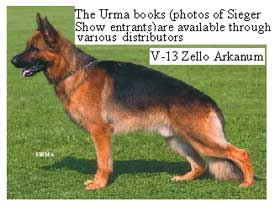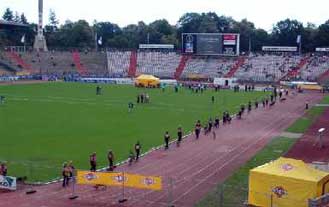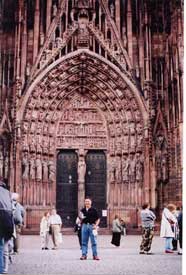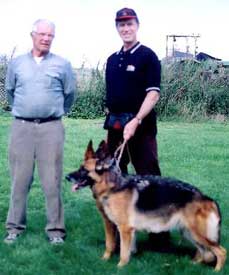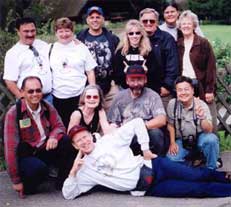It was another great show, another great tour, and another wonderful group that I conducted to see the biggest breed show in the world, followed by sightseeing and breeder visits. This year, with the show again in Karlsruhe, we also had the opportunity to tour a little of France, sample the wines of Alsace, and see the birthplace of the sculptor of the Statue of Liberty.
The show itself, a 3-day affair and this year with about 2,200 GSDs, is the experience of a lifetime for many fanciers. A few join my guided tour group (the only non-profit one going) again, but most are first-timers; many additionally are novices in both European travel and in the breed, so everybody gains a great deal. The relative uniformity of the international-style GSD (which by definition excludes most of the “Alsatians” and “AKC-types”) is marvelous to behold. The novice finds it hard to tell them apart until someone points out subtle differences.
If you are not a GSD person, just skip over the names of the dogs or the info on the courage test, something that is required to pass before admittance into the conformation competition for dogs and bitches over 24 months of age. Incidentally, dogs are strictly limited to the classes comprising their ages. There are no other class divisions except for the small (age-separated, again) herding-titled dogs. The 24-months and up classes require a Schutzhund title or equivalent, and the HGH dogs also have elements of protection in those herding titles, so such things as courage and gunsureness/strong nerves are constantly being selected for this way.
The question of how much turmoil and change might come about with the change of judges for the all-important Working Males class (those 24 months and older with working titles) turned out to be needless worry. Erich Orschler did not rock any boats or even make small waves as he put up for Sieger/VA-1 the dog almost everyone expected to someday get the title, Larus v. Batu. The fact that the judge bred him was nothing for him to worry about, either, as Orschler is retiring from judging after this year (mandatory in the SV’s discriminatory age-limit rules). It would have done no good, anyway, if anyone had complained. Larus pretty much earned his place.
At one point I was able to get inside the inner sanctum and collar the SV president and talk with him about the changes he and the board had in mind. Herr Wolfgang Henke told me that he would be trying to rotate the job of judging the adult males in the future. Historically, one man (usually the president) would do the honors year after year, and another would do the adult (over 2 years) females every time; Leonhard Schweikert has been judging that class for the past few years since Helmut Buss got fired. It will be interesting to see how the rotation is handled, but I doubt if there will be much further change in the methods, top dogs, or anything else. After all, SV judges are thoroughly trained and watched to make sure they all judge the same way, and see pretty much the same things in the dogs. By the time they have judged a few 12-18 and/or 18-24-mo. classes, they are quite predictable. This is not an AKC-type game where one will pitch underhand, the next will pitch overhand, and a third will roll the ball across the plate — all of us SV judges are rigorously trained the same way.
Dogs get to the top VA (excellent-select) category by doing well in the previous year’s younger classes at the Sieger Show, and by doing a lot of winning during the spring and summer leading up to the big show. They have to prove themselves many times, not just fly in and make a single flash-in-the-pan appearance. Another usual prerequisite is showing a good progeny class. If the young adult has no progeny on the ground or has not produced anything notable yet, it is highly unlikely he will get a top berth in the V categories at the Sieger Show.
One of the very important parts of the show for the breeder and buyer is held on the first day, Friday. Last year at Ulm (where it will be again in 2005), we had the good fortune to be able to see both the females and the males do their courage test qualifications for entry into the conformation ring. The fields are separated by a canvas fence so the dogs cannot see the “helper” (agitator) work going on in the other field; at Karlsruhe, there is only a low earthen stepped bank to sit on, so observers cannot see both at once, either. It is by close observation of the dogs’ performance that many breeding decisions are formed or reversed. For example, a friend in Georgia who was going to breed his bitch to the flashy Zamp Thermodos a couple days after the show changed his mind when the dog failed to get Ausgeprägt by refusing to convincingly engage (attack and bite confidently when pressed by the helper). Zamp is too “good” a dog in many minds, not to have a year of preparation ahead of him for the next chance; Ghandi Arlett failed last year, and it was very obvious a lot of work went into getting his biting routine flawless for this year’s show — as a result, he was VA-8 this year. Watch for Zamp to do similarly.
Of course, there’s always the chance such a dog may go to a country with big wallets and no courage test requirements, the way VA-10 Huppy Arlett did. Huppy was sold to China after his failure. I judged him in 2003 as an older dog, in Beijing, and he still had tremendous powerful drive and reach. The handsome Esko son, V-4 Chuck van der Lust, had also failed to qualify in 2003 but is back in the statistics this year. This year the judging of the courage test for males was a big disappointment to me. There were so many dogs that I would have given a “Vorhanden” (“present”) but that the judge gave “Ausgeprägt” (pronounced)!
Since the bitework means so much to me, and even though I acknowledge that performance by a show-lines dog may be a result of less training than that of a working-lines dog, I want to mention some specific dogs. Friday is a very long day, but I saw nearly every male do his work. The beautiful Orbit Tronje son Gonzalez could have had a slightly better second bite (the long-distance attack), but that was no reason to pull him from competition. I am guessing that the reason he is listed in the results as “EZ” (excused) was because his owner did not like his initial and temporary placing after the “individual exams”. The dogs after leaving the bite test go to the main arena for the stand-for-exam and gaiting, and the breed judge there gives them their rough position in the line-up. It is here that many owners, dissatisfied with the starting position given, find some excuse not to bring the dog back for the group judging later. The tabulation does not list the details, but it’s an open secret that all these “entschuldigt zurückgezogen” (pulled & excused) dogs certainly cannot have taken sick, even though on paper the only way to do so is to get the official vet to give a paper that is then handed to the judge or his steward. It’s a big, shameful joke. The dog gets a slap on the wrist (very temporary breeding ban but by then he has probably used up most of his allowed number of stud services anyway) and can start anew not long afterwards. Owners feel it’s a good trade for not having the dog’s name so openly listed lower in the rankings than his competition — after all, not that many people look at the end for the names of those excused.
The Triumph’s Gucci sons such as V114 Enzo Blauen Kristall and V113 Apoll Basileia, Henry Dunieschenke son V7 Mark Schwalmbergtal, VA-1 Larus, VA2 Hill, VA3 Erasmus, VA4 Orbit Huhnegrab, VA5 Quirin, and VA7 Ando; Romeo Pallas-Athene’s UK son V9 Elan Herderskring bred by Peter Oirschot, Huppy son V128 Hobby Farbenspiel, Cento Monopteros son V60 Kerry Torberg, Baru Haus Yu’s sons V65 Ricco Domaine du Parc and V26 Merlin Aurelius, Untox son V20 Canto Frankengold, Quartz Templari’s great-working 6-year-old V147 Hero Spitalfeld, the Hoss son Karo Herdersfarm (EZ), the Yasko sons U-5 Kuschy Blue-Iris (U is Insufficient in conformation) and Athos Friesenblick, and V28 Ghildo (an Italian son of Til Lechtal) all did notable jobs in this regard. Even better were performances by the Ando son V39 Boy Tönsbruck who flew through the air for a great grip, V138 Alf Hammer Burg, V66 Focus Maarue, and V87 Rambo Hellufer, some of whom were from working-lines kennels. Best of all in the courage test, though was V144 Ursus Fürstentum Lippe bred by R. Kämpfer of Bielefeld, an area with many good trainers. Not very good in temperament/bitework were too many of the sons of Yello St.Michaels-Berg (Enzo Buchhorn); you will read in last year’s report that I said of Yello himself: “he took too many re-bites in the Schutzdienst for my liking.” Genetics will out!
Otherwise promising dogs pulled after the standing exam included Yak Frankengold, Oliver Laacher-Haus, and Karo Herdersfarm. Failing the test were nice-looking dogs such as Boss Elzmündungsraum and Natz Herdersfarm, the latter offered to a friend of mine recently for about $30,000! Additionally, several nice dogs were missing from the scene; for example, Untox, Whisky, and Nero have been sold to China.
I have already reported several placings, but want to also mention that Karat’s Ulk, a Danish dog, was in approximately 5th place toward the end, but was moved out of the VA category in the last moments because of ineligibility. His mother’s papers were not acceptable to the SV because both her parents had not a German Körung (breed survey). So according to the rules, he could not get a VA and ended up as V-1. The V2 Karat’s Yoker, is from the same kennel in Denmark.
In the bitch class over 24 months, daughters of the following stud dogs won top honors (their names are to be found on the Internet: http://www.schaeferhund.de/06_veranstaltungen/BSZ04/PDF/HUNDE.pdf )
VA-1 and Siegerin: Wallace Agrigento, VA2: Ursus Batu, VA3: Esko DänischenHof, VA4: Quantum Arminius, VA5: Pascha Jahnhöhe, VA6: Nils Wildsteigerland, VA7: Orbit Tronje, VA8: Filou Quartier Latin, VA9: 2003 Sieger Bax, VA10: Xenius van Noort, VA11: Kevin Murrtal. Another Wallace daughter got V-1. My favorites among the bitches were the VA2, 3, and 7, the last being the beautiful Orbit daughter Shalome who did such a great job last year in the courage test as well as in gaiting both then and this year. For a description of the VA males, see my “Impressions” of the 2003 show on this and other websites. VA9 Pakros Ulmental was the lone addition, and is a very well-constructed son of Bax Luisenstrasse, with better ribbing, topline, and pasterns than most Bax offspring, who tend to be too narrow. As a son of a Sieger, he is bound to move up considerably next year, especially after presenting a good progeny class.
Ando daughter Aebby Villa Musica got V7. She is a litter sister to the Alegra bitch I just trained and titled, and is really beautiful. V73 Wende Trienzbachtal is impressive in the ring and also at home (I took my group to this famous breeder’s house in the days following). V56 Sheila, a Timo daughter, also impressed me, as did the Ando daughter Whoopi Zauberwald (Youth Class SG-30). There were so many that I would have been proud to own, with quality running very deep in every class.
This year, the 12-18 month classes were in fields far removed from the 18-24-month animals, so it was difficult to watch them both. However, my people got the opportunity to see many of the future years’ stars in these four classes. I spent much of Saturday looking at the older males judged by Chief SV Körmeister Heinz Scheerer. After his work, I chatted in the ring with him and brought him up to date on the Ando daughter I had titled, and who had impressed him so much with her bitework when he did her breed survey. Alegra is owned by Andrew Masia of Boca Raton, Florida and has recently been bred to a new import. All the Ando progeny I’ve seen so far are eager, energetic learners and do very well on the bitework. One to watch for is the terrific Rocky Tepford, who was absent from the show this year, but who is the sire of my current litter, born at our kennel in Holland.
Also on Saturday is the important Progeny Class competition, with a chance to see very large collections of offspring from each of many popular studs. One can gain some general impressions on how well dogs reproduce themselves with various bitches. Some Wallace sons are gaining in importance and by next year should show considerable uniformity, although others appear a bit bitchy in the heads, as do many Sieger Yasko sons. On the other hand, Yasko son Erasmus is producing mostly magnificent Hobby types (Ursus’ father, a really masculine stallion). Great pigment comes with the Ando AltenbergerLand and Nero Nobachtal progeny, many small hindquarters and steep croups are seen in offspring of Wallace and Ghandi, nice reach and firm overlines are seen in most Whisky BierstadterHof (Ursus) and Esko progeny, and mostly good proportions and uniformity are seen in classes presented by Kevin and Dux della Valcuvia, though in each of these two cases fronts could have been better. Kevin, coming from Sieger Rikkor, cannot be expected to improve on length of upper arm. Hill’s and Erasmus’ groups had very uniform and good size and masculinity. Larus naturally had the largest progeny group, and most were very attractive, although he has the same problem his sire Yasko has, that of many males that could look more like males. Now, remember: this is a relative thing, and any of them would likely put the male classes in a typical AKC-GSDCA show to shame in that respect.
Sunday is the “Big Day” when the top 70 or 80 or so “Working Class” of each sex come in for the final competition. That’s 24-months and older, with titles, almost all IPO or SchH (now being called VPG), and who have “made the cut”. The lower 150 or so have been already ranked on Saturday and can relax in their trailers. The process of walking, running, off-leash fast running, and group down-and-back enables the judges to shuffle some around to make sure every dog is where it belongs in their sight. It’s a beautiful vista, looking down on the spectacle, and I make sure the novices in my group don’t miss much in regard to anatomy and movement. Everybody has binoculars and a catalog, and can follow the action. Other Sunday events are the presentation of the top 20 in each of the other age groups (all dogs at a Sieger Show are over 12 months), the kennel groups, and special awards.
The tour begins! After the show each year, I take my people to see the countryside, get a taste of European country life, history, scenery, and introduce them to breeders and judges. Following the show weekend, we started off after Frühstuck (the hearty wake-up meal usual on the continent, but nothing like the weak excuse for a meal that Americans call a “continental breakfast”) at our hotel in Karlsruhe, and drove our three vehicles over the Rhine (Rhein) into France, then south into the province of Alsace. This area has been claimed successively many times by Germany and France, so there are signs of both languages and cultures there. It is an area of fine white wines and great cuisine. A stop in Strasbourg gave all the group a taste of French city life as well as those incomparable croissants. Historic cathedrals in Europe were generally spared the destruction of WW-2 bombing raids, especially outside German borders, and are always included on my tours.
Next was the fantastically colorful town of Colmar further to the south, the birthplace of Bartholdi, the sculptor of the Statue of Liberty, perhaps France’s last gesture of thanks to the U.S. Window boxes of flowers were everywhere, and multi-colored tile roofs of ancient buildings echoed their splendor. Crossing the river again, we drove to Freiburg and looked around the main square and the shops. Unfortunately, we arrived after 5pm when the tall church with the 500-ton bell had closed to tourists for the evening. So, after some shopping for Black Forest memorabilia, we headed north to the rural beauty of Bollenbach and the friendly hospitality of the innkeepers as well as a local breeder of great excellence.
Our first visit that evening and again the next morning was to Hermann Beil’s Schornfelsen kennel. His is an immaculate home operation with few dogs but high quality. This year the sale of four puppies resulted from these introductions, one Schornfelsen litter being sired by Erasmus (who I think has a good chance of being Sieger next year) and out of a daughter of the great Jango Fürstenberg. His Diego, a 12-month Quirin son also available, impressed the group with his masculinity, pigment, personality, and gait. We later visited Leopold Bucher’s famous Trienzbachtal kennel, home of many Siegerins and VA dogs over the years, met Wende up close and posed for photos with many of his dogs.
Also on that trip we toured the up-and-coming Arkanum kennel run by Robert Lang, and a couple more. His dog Zello got V13 and Robert told me a litter brother is available for sale, as is a Wallace daughter and some youngsters. The kennel facility is a model of cleanliness and healthy atmosphere. Down the lane from Lang’s place is what’s left of the monumentally famous Pelztierfarm kennel, but the owner is languishing in a rest home and does not know anybody or anything. Presumably it’s Altzheimer’s. I was too late to touch bases with that breeder of the great Mutz, one of the pillars of the breed. Thankfully, I had a chance many years ago to visit with Alfred Hahn of Busecker Schloss (he started this kennel in 1925) before he got feeble and wasted away. The last kennel of the day was seen at night, but many nice dogs were brought out for us to look at. This was one of the sources for dogs my friend and our traveling companion Ahmed Virk uses to procure dogs for the Pakistan Air Force and Army, so they were happy to show us what they had.
Wednesday night after supper we split up, with half the group set to fly from Frankfurt and the other half from Stuttgart. Unfortunately, one couple in my planned entourage could not get to Germany; he is a Spaniard but his wife is Colombian, and as a result, her passport was held up by the German consulate (possibly in the U.K.) long enough to miss the show. It’s terrible how politics and the mismanagement of “security” can adversely affect our lives and the enjoyment of such pleasures as this Sieger Show tour. I was really looking forward to meeting this couple. It is a good idea for everyone to make sure well in advance that passports and airline reservations are in order, and visa are approved, if you live in a country where that is required of you.
For those interested in joining us next year, here are some answers to commonly-asked questions. Each person makes his own plane reservations, and we meet at an airport of my choice, although this year for various reasons it was better that we “rail” into Karlsruhe and not start paying for rental vans until Monday. Each is responsible for his own food, hotel bills, and admission. I rent the vehicles, enlist a driver or two, reserve hotels at the best prices and locations, and arrange introductions and sights of interest and historical significance. Each year the show is held in a different place from the previous year, but many are returned to, so I try to vary the tours so that repeat group members do not have exactly the same experience. For example, in 2005 we will all fly to Munich and we will see some different castles and additional breeders. If you want your well-behaved teen to have a better education and a better chance to grow up by interacting with adults than is possible in school for a couple of weeks, there are always plenty of mature members of the group to help keep an eye on him/her, so feel safe in sending your youngster if you can’t get off work yourself. E-mail me and start planning!
Contact me at if you’d like to come to Bavaria in 2005 or Holland after the 2006 show in Dusseldorf. This is always an experience that will be relished by all dog lovers, regardless of breed, and there are enough other diversions to occupy the non-doggy spouse or friend who’d like to see part of Europe under experienced tutelage and guidance.
|
|
|
|
|
|
|
|
|

